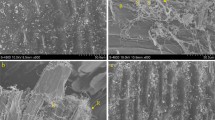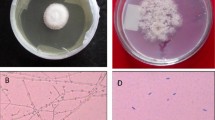Abstract
A batch culture technique was used to evaluate dry matter (DM) digestibility of corn stover (Zea mays L.) and kudzu, Pueraria montana (Lour.) Merr. after solid-state fermentation (SSF) with a white-rot fungus, Pleurotus ostreatus (Jacq. ex Fr.) P. Kumm. Five dietary treatments consisting of mixtures of corn stover (C) and kudzu (K) in varying ratios, (1) 100C:0K, (2) 75C:25K, (3) 50C:50K, (4) 25C:75K, and (5) 0C:100K, were inoculated with P. ostreatus (MBFBL 400) and subjected to SSF for 0, 35, and 77 days. The study was arranged as a 5 × 3 factorial design with 3 replicates. Grass hay was included in the study as a control. Interactions (P < 0.05) between treatments and fermentation time were noted for the fermentation kinetics. Asymptotic gas was the highest (P < 0.05) for 0C:100K and 100C:0K on day 77. Treatment effect (P < 0.001) and treatment × fermentation time interaction (P < 0.001) were noted for in vitro dry matter digestibility (IVDMD). On day 77, treatment 4 had the highest (P < 0.001) IVDMD value, while treatment 1 had the lowest (P < 0.001) IVDMD. There was no difference (P > 0.05) between treatments 3, 5, and control. Numerically, the ranking of their IVDMD values from the highest to the lowest is 4 > 2 > 5 > control >3 > 1. The results show that the treated corn stover and kudzu mixes were comparable with the control, which is good quality hay. This is the first report that demonstrates the potential use of a combined mixture of corn stover and kudzu in ruminant animal feed development.

Similar content being viewed by others
References
Anele UY, Swift M-L, McAllister TA, Galyean ML, Yang WZ (2015) Evaluation of models for predicting acidosis risk of barley grain in finishing beef cattle. J Anim Sci 93:4852–4859
Anike FN, Yusuf M, Isikhuemhen OS (2016) Co-substrating of peanut shells with cornstalks enhances biodegradation by Pleurotus ostreatus. J Bioremed Biodeg 7:327
Awafo VA, Chahal DS, Charbonneau R (1995) Effect of irradiation, as a pretreatment, on bioconversion of corn stover into protein-rich mycelial biomass of Pleurotus sajorcaju. Radiat Phys Chem 46:1299–1302
Balan V, da Costa SL, Chundawat SPS, Vismeh R, Jones AD, Dale BE (2008) Mushroom spent straw: a potential substrate for an ethanol-based biorefinery. J Ind Microbiol Biotechnol 35:293–301
Berry DP (2009) Improving feed efficiency in cattle with residual feed intake. In: Garnsworthy PC, Wiseman J (eds) Recent advances in animal nutrition 2008. Nottingham University Press, Nottingham, UK, pp 67–99
Blummel M, Karsli A, Russell JR (2003) Influence of diet on growth yields of rumen microorganisms in vitro and in vivo: influence on growth yield of variable carbon fluxes to fermentation products. Br J Nutr 90:625–634
Boga M, Yurtseven S, Kilic U, Aydemir S, Polat T (2014) Determination of nutrient contents and in vitro gas production values of some legume forages grown in the Harran plain saline soils. Asian-Aust J Anim Sci 27:825–831
Buxton DR, Russell JR (1988) Lignin constituents and cell-wall digestibility of grass and legume stems. Crop Sci 28:553–558
Connor EE (2015) Invited review: improving feed efficiency in dairy production: challenges and possibilities. Anim 9:395–408
Corley RN, Woldeghebriel A, Murph MR (1997) Evaluation of the nutritive value of kudzu (Pueraria lobata) as a feed for ruminants. Anim Feed Sci Technol 68:183–188
Devendra C, Leng RA (2011) Feed resources for animals in Asia: issues, strategies for use, intensification and integration for increased productivity. Asian-Aust J Anim Sci 24:303–321
Donkin SS, Doane PH, Cecava MJ (2013) Expanding the role of crop residues and biofuel co-products as ruminant feedstuffs. Anim Front 3:54–60
Flachowsky G, Isikhuemhen OS, Wagner K, Loose K, Zadrazil F (2001) In sacco degradability of wheat straw residues after growing of Lentinus tuberregium (Fr). Fr J Appl Anim Res 20:33–40
Forseth IN, Innis AF (2004) Kudzu (Pueraria montana): history, physiology, and ecology combine to make a major ecosystem threat. Crit Rev Plant Sci 23(5):401–413. https://doi.org/10.1080/07352680490505150
Getachew G, Blummel M, Makkar HPS, Becker K (1998) In vitro gas measuring techniques for assessment of nutritional quality of feeds: a review. Anim Feed Sci Technol 72:261–281
Hatfield RD, Ralph J, Grabber JH (1999) Cell wall structural foundations: molecular basis for improving forage digestibilities. Crop Sci 39:27–37
Heleno SA, Ferreira RC, Antonio AL, Quieroz MRP, Barros L (2015) Nutritional value, bioactive compounds and antioxidant properties of three edible mushrooms from Poland. Food Biosci 11:48–55
Hoffberg SL, Mauricio R (2016) The persistence of invasive populations of kudzu near the northern periphery of its range in New York City determined from historical data. J Torrey Bot Soc 143:437–442
Hickman JE, Wu S, Mickley LJ, Lerdau MI (2010) Kudzu (Pueraria montana) invasion doubles emissions of nitric oxide and increases ozone pollution. P Natl Acad Sci 107(22):10115–10119. https://doi.org/10.1073/pnas.0912279107
Isikhuemhen OS, Mikiashvilli NA (2009) Lignocellulolytic enzyme activity, substrate utilization, and mushroom yield by Pleurotus ostreatus cultivated on substrate containing anaerobic digester solids. J Ind Microbiol Biotechnol 36:1353–1362
Isikhuemhen OS, Mikiashvili N, Senwo Z, Ohimain E (2014) Biodegradation and sugar release from canola plant biomass by selected white rot fungi. Adv Biol Chem 4:395–406
Karabulut A, Canbolat O, Kalkan H, Gurbuzol F, Sucu E, Filya I (2007) Comparison of in vitro gas production, metabolizable energy, organic matter digestibility and microbial protein production of some legume hays. Asian-Aust J Anim Sci 20:517–522
Klopfenstein TJ, Mass RA, Creighton KW, Pattern HH (2001) Estimating forage protein degradation in the rumen. J Anim Sci 79:E208–E217
Ladisch MR, Lin KW, Voloch M, Tsao GT (1983) Process considerations in the enzymatic hydrolysis of biomass. Enzym Microbial Tech 5:81–102
Liu Y, Zhao C, Lin D, Lin H, Lin Z (2015) Effect of water extract from spent mushroom substrate after Ganoderma balabacense cultivation by using JUNCAO technique on production performance and hematology parameters of dairy cows. Anim Sci J 86:855–862
Luz JM, Nunes MD, Paes SA, Torres DP, Silva CSM, Kasuya MC (2012) Lignocellulolytic enzyme production of Pleurotus ostreatus growth in agro-industrial wastes. Braz J Microbiol 43:1508–1515
Mata G, Savoie JM (1998) Extracellular enzyme activities in six Lentinula edodes strains during cultivation in wheat straw. World J Microbiol 14:513–519
Mauricio RM, Mould FL, Dhanoa MS, Owen E, Channa KS, Theodorou MK (1999) A semi-automated in vitro gas production technique for ruminant feedstuff evaluation. Anim Feed Sci Technol 79:321–330
Mertens DR (1994) Regulation of forage intake. In: Fahey GC Jr (ed) Forage quality, evaluation, and utilization. ASA, CSSA, SSSA, Madison, Wisconsin, pp 450–493
Mukherjee R, Nandi B (2004) Improvement of in vitro digestibility through biological treatment of water hyacinth biomass by two Pleurotus species. Int Biodeterior Biodegrad 53:7–12
Mikhailova E, Cherney D, Snyder LU, Post C, Sharp J, Cox S, Kelly S (2013) Effects of drought on nutritive value of Kudzu. Commun Soil Sci Plan Anal 44(22):3412–3422. https://doi.org/10.1080/00103624.2013.847455
Niu D, Zuo S, Jiang D, Tian P, Zheng M, Xu C (2018) Treatment using white rot fungi changed the chemical composition of wheat straw and enhanced digestion by rumen microbiota in vitro. Anim Feed Sci Technol 237:46–54
Obodai M, Cleland-Okine J, Vowotor KA (2003) Comparative study on the growth and yield of Pleurotus ostreatus mushroom on different lignocellulosic by-products. J Ind Microbiol Biotechnol 30:146–149
Ørskov ER, McDonald I (1979) The estimation of protein degradability in the rumen from incubation measurements weighted according to rate of passage. J Agric Sci (Camb) 92:499–503
Rao PP, Hall AJ (2003) Importance of crop residues in crop-livestock systems in India and farmers' perceptions of fodder quality in coarse cereals. Field Crop Res 84:189–198
Ren H (2006) Effect of cell wall degrading enzymes and chemicals on corn stover preservation and pretreatment during ensilage process. Dissertation, The Pennsylvania State University, University Park, PA, USA, Ph.D
Rueda BL, Blake RW, Nicholson CF, Fox DG, Tedeschi LO, Pell AN, Fernandes ECM, Valentim JF, Carneiro JC (2003) Production and economic potentials of cattle in pasture-based systems of the western Amazon region of Brazil. J Anim Sci 81:2923–2937
Sharma KK, Shrivastava B, Nandal P, Sehgal N, Sastry VRB, Kalra A, Kuhad RC (2012) Nutritional and toxicological assessment of white-rot fermented animal feed. Indian J Microbiol 52:185–190
Shrivastava B, Thakur S, Khasa YP, Gupte A, Puniya AK, Kuhad RC (2011) White-rot fungal conversion of wheat straw to energy rich cattle feed. Biodegrad 22:823–831
Sun Y, Cheng J (2002) Hydrolysis of lignocellulosic materials for ethanol production: a review. Bioresour Technol 83:1–11
Singh S, Kushwaha BP, Nag SK, Mishra AK, Singh A, Anele UY (2012) In vitro ruminal fermentation, protein and carbohydrate fractionation, methane production and prediction of twelve commonly used Indian green forages. Anim Feed Sci Tech 178(1–2):2–11
Tan Z, Liu S, Bliss N, Larry L, Tieszen LL (2012) Current and potential sustainable corn stover feedstock for biofuel production in the United States. Biomass Bioenergy 47:372–386
USDA (2011) Interagency agricultural projections committee. USDA agricultural projections to 2020. US Department of Agriculture, Washington DC (2011 Feb), 100 pp long-term projections report OCE-2011-1
Van Soest PJ (1994) Nutritional ecology of the ruminant (2nd ed). Comstock Pub, Ithaca, New York, 476 pp
Van Soest PJ, Robertson JB, Lewis BA (1991) Methods for dietary fiber, neutral detergent fiber, and non-starch polysaccharides in relation to animal nutrition. J Dairy Sci 74:3583–3597
Wasser SP (2002) Medicinal mushrooms as a source of antitumor and immunomodulating polysaccharides. Appl Microbiol Biotechnol 60:258–274
Xu X, Yan H, Chen J, Zhang X (2011) Bioactive proteins from mushrooms. Biotechnol Adv 29:667–674
Zhang M, Cui SW, Cheung PCK, Wang Q (2007) Antitumor polysaccharides from mushrooms: a review on their isolation process, structural characteristics and antitumor activity. Trends Food Sci Technol 18:4–19
Zhao S, Li G, Zheng N, Wang J, Yu Z (2018) Steam explosion enhances digestibility and fermentation of corn stover by facilitating ruminal microbial colonization. Bioresour Technol 253:244–251
Funding
The authors would like to acknowledge financial support from the Agriculture and Food Research Initiative (AFRI) of the United States Department of Agriculture. This study is part of an AFRI grant (NC.XAFRI-2018-08391) integrating cattle farming, mushroom production, and abundant corn stover for year-round farm profitability. The undergraduate student Alexia Mitchell-Davis’s participation in this project was supported by the Multicultural Scholars Program (MSP), United States Department of Agriculture National Institute of Food and Agriculture (USDA-NIFA) grant (2014-38413-21797).
Author information
Authors and Affiliations
Contributions
Uchenna Y. Anele designed the study, performed research, analyzed data, and prepared the first draft of the manuscript. Felicia N. Anike designed the study and performed research and manuscript preparation. Alexia Davis-Mitchell performed research. Omoanghe S. Isikhuemhen designed the study and performed research and manuscript preparation.
Corresponding author
Additional information
Publisher’s note
Springer Nature remains neutral with regard to jurisdictional claims in published maps and institutional affiliations.
Rights and permissions
About this article
Cite this article
Anele, U.Y., Anike, F.N., Davis-Mitchell, A. et al. Solid-state fermentation with Pleurotus ostreatus improves the nutritive value of corn stover-kudzu biomass. Folia Microbiol 66, 41–48 (2021). https://doi.org/10.1007/s12223-020-00817-1
Received:
Accepted:
Published:
Issue Date:
DOI: https://doi.org/10.1007/s12223-020-00817-1




